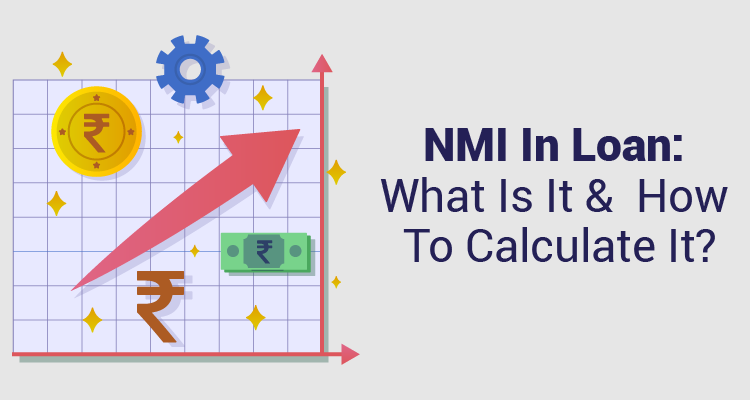What is NMI & How to Calculate It In Loan?

Banks and NBFCs evaluate multiple criteria to determine the eligibility for a loan. These criteria are typically consistent across most lending institutions and include factors such as credit score, age, income, occupation, and the applicant's employer profile. Lenders mostly employ the Multiplier Method to calculate the sanctioned loan amount. In this method, the loan amount is calculated as a multiple of the applicant’s net monthly income. It can be anywhere between 10 to 24 times of their monthly income. Another method used by lenders to calculate the loan amount eligibility is the EMI/NMI ratio. This ratio has two components – EMI and NMI. EMI, a more popular term, stands for “Equated Monthly Installment”. It is the fixed monthly installments that borrowers make towards the repayment of the loan. But what is NMI?
NMI Full Form
NMI in Loan terms is the "Net Monthly income". It is the disposable income that a borrower receives every month after meeting his regular expenses and deduction of taxes and any other outstanding liabilities.
How to calculate NMI in loans?
To understand how banks calculate NMI in loans consider an example. Suppose Mr. X has a gross monthly income of Rs. 1,50,000. His regular living expenses is Rs. 24,000. He also pays Rs. 11,000 in taxes each month. So, NMI of Mr. X would be: Rs. 1,50,000 – ( Rs. 24,000 + Rs. 11,000)= Rs. 1,15,000
Zaroorat aapki. Personal Loan Humara
Apply NowEMI/NMI Ratio
The EMI/NMI ratio is calculated by dividing the borrower’s monthly EMI by the monthly NMI. Lenders use this ratio primarily to assess whether a borrower has sufficient NMI to cover their monthly living expenses in addition to meeting their loan repayment obligations.
During the calculation, banks include all EMIs towards the existing loans and the proposed loan. Most lenders prefer applicants to have an EMI/NMI ratio of up to 50-55%. In some cases, the percentage can be increased by adding a co-applicant while applying for a loan.
The computation of net monthly income varies for salaried and self-employed individuals:
- Salaried Persons: NMI comprises the total statutory deductions like provident funds and other similar items.
- Other than Salaried Persons: Since the monthly income for people for non-salaried persons may not follow a regular pattern, NMI is calculated based upon NAI (Net Annual Income). It essentially means annual income as per latest income tax return filed.
The EMI/NMI ratio can vary from 20% to 70% depending on the applicant’s net annual income. Most lending institutions impose an upper limit on the EMI/NMI ratio. Typically, the maximum loan amount is determined in a manner that ensures the EMI/NMI ratio remains within the predetermined boundaries.
Nevertheless, applicants with exceptional credit profiles may receive special consideration as some banks may authorise the local sanctioning officers to relax the EMI/NMI ratio limits to certain extent.
Using the previous example of Mr. X, let’s assume that a bank offers him a 25% EMI/NMI ratio on that income slab. So, then the maximum EMI amount Mr. X can opt for, is 25% of INR 1,15,000 which is 28,750. But if Mr. X invests Rs. 5000 in a new monthly SIP scheme, then the maximum EMI amount Mr. X can get further is Rs. 28,750 – Rs. 5,000 = INR 23,750.
Why is NMI important?
The monthly income is an important criteria since the EMI/NMI ratio is different for different monthly income slabs. So, an individual with a higher monthly income can get a higher personal loan amount, provided the individual has no existing obligations like credit card EMIs.
Conclusion
The foremost criteria for lenders while considering a loan application is to evaluate the repayment capacity of an individual. Almost every lender has a fixed norm about the monthly income.
From the customers’ perspective, the EMI/NMI ratio helps to determine the maximum loan amount that can be borrowed based on the NMI after deducting the existing liabilities which also includes the new loan EMI. Typically, lenders sanction personal loans to applicants having EMI/NMI ratio of up to 50-55%.
A few other factors that determine the personal loan eligibility are applicant’s credit score, work experience, etc. Since the eligibility criteria tends to vary from one lender to another, it will be prudent to compare the lending terms before making a pick.
IIFL Finance is a leading financial institution engaged in personal loans, business loans, gold loans, etc. to suit the needs of every customer. All the loans have attractive interest rates and are offered against minimal documentation.
Sapna aapka. Business Loan Humara.
Apply NowDisclaimer : The information in this blog is for general purposes only and may change without notice. It does not constitute legal, tax, or financial advice. Readers should seek professional guidance and make decisions at their own discretion. IIFL Finance is not liable for any reliance on this content. Read more



